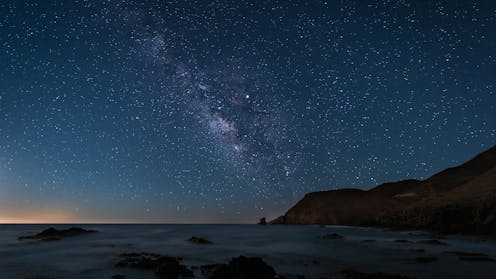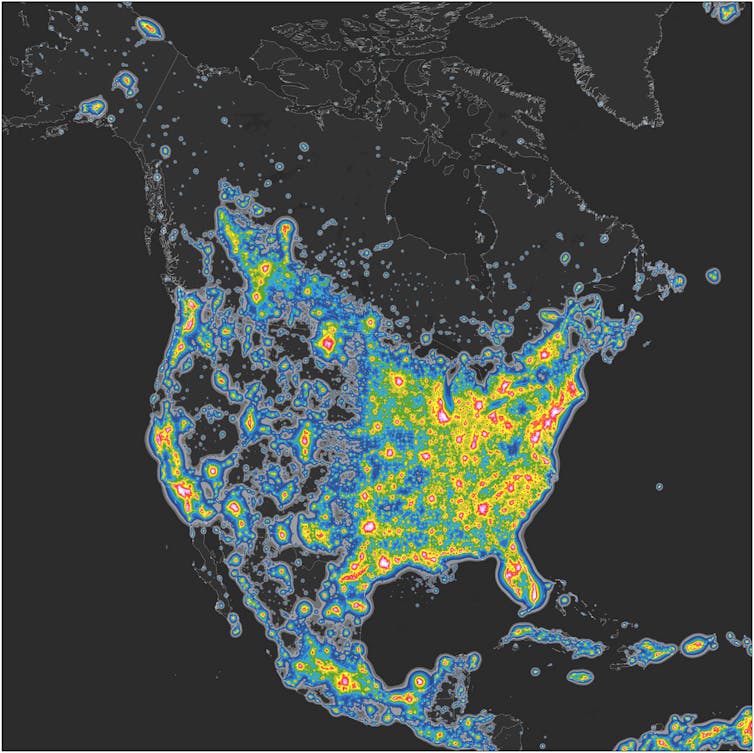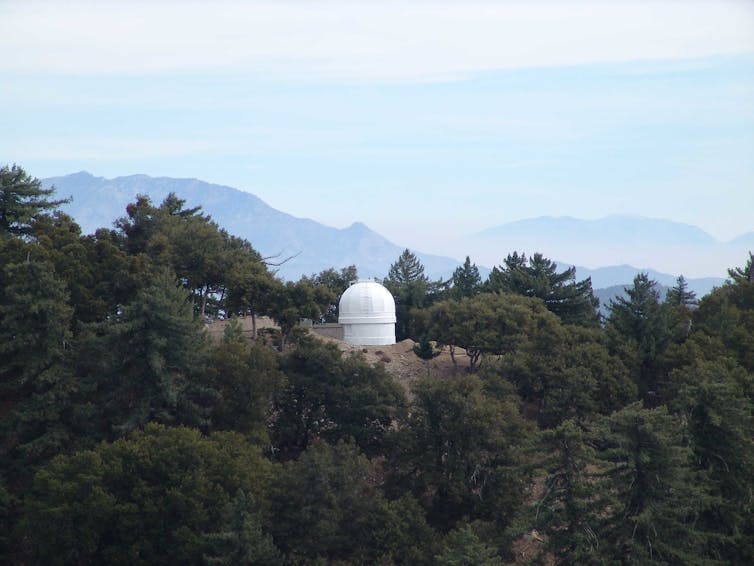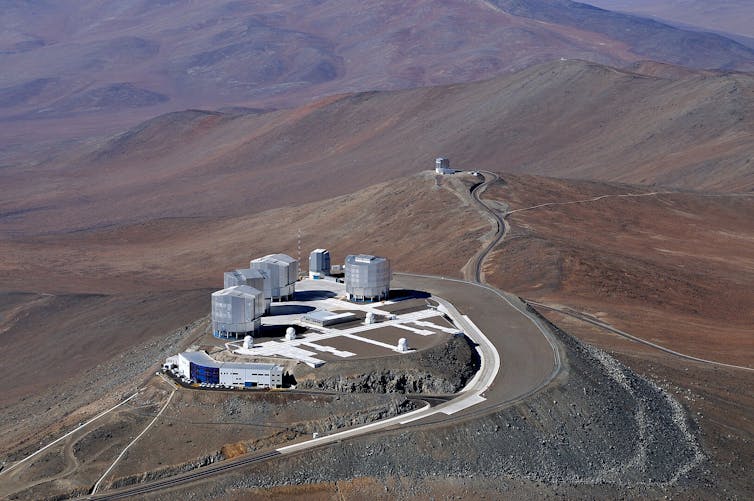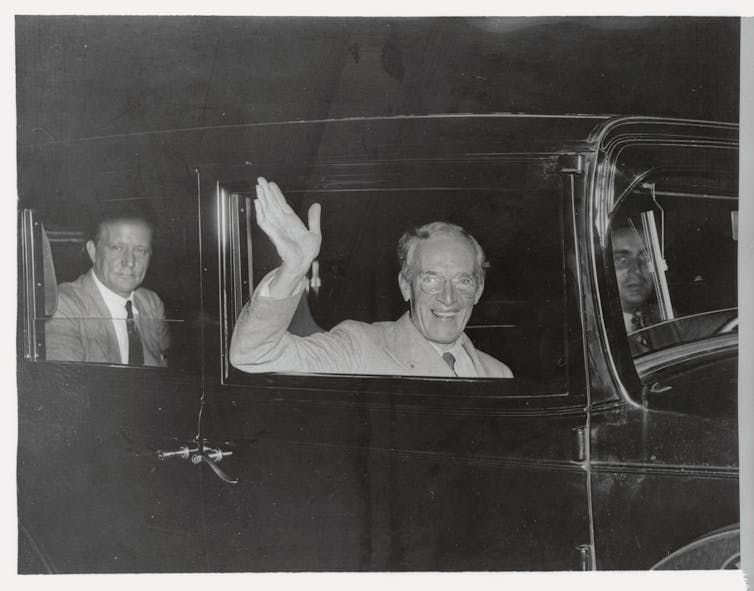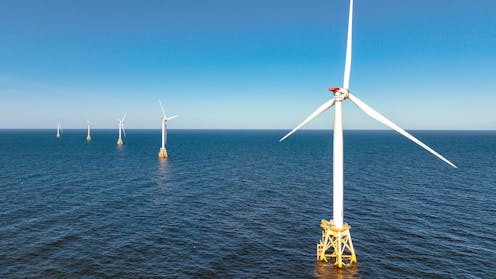Source: The Conversation – France (in French) – By Etienne Faugier, Maître de conférences en histoire, Université Lumière Lyon 2
On l’appelle « autoroute du Soleil », voire « autoroute des vacances ». L’A7, au sud de la France, est un axe touristique emblématique. Retour sur l’histoire de sa construction, indissociable de l’ère des congés payés, et sur les défis environnementaux, sociaux et économiques auxquels elle fait face.
En juillet et août, l’autoroute A7, qui relie Lyon à Marseille, est un axe particulièrement emprunté par les automobilistes, camionneurs, motocyclistes, caravanistes et autres camping-caristes. Habituellement chargée le reste de l’année par les poids lourds, elle fait alors l’objet de chassés-croisés entre juilletistes et aoûtiens.
Il s’agit d’un axe majeur du réseau autoroutier français, qui dit beaucoup de choses sur le passé, le présent et l’avenir de la société française. Sa construction s’inscrit dans un moment bien particulier de l’histoire, et elle fait face aujourd’hui à de nouveaux enjeux environnementaux, économiques et sociaux.
Aux origines des projets d’autoroutes
Les projets autoroutiers remontent au début du XXe siècle. Ils se sont développés avec l’essor de la motorisation dans une volonté d’accélérer les déplacements en séparant les modes de transport motorisés des autres modes. Un premier tronçon d’autoroute est construit aux États-Unis autour de Long Island (dans l’État de New York) en 1907. Mais c’est véritablement de Milan aux lacs de Côme et Majeur (Italie), en 1924, que l’on voit apparaître la première autostrada. Le Reich allemand suivra, en 1935, avec une autoroute de Francfort et Darmstadt (dans le Land de Hesse).
En France, dès les années 1930, des propositions d’autoroute voient le jour et notamment, en 1935, la Société des autostrades françaises (SAF) propose un itinéraire entre Lyon (Rhône) et Saint-Étienne (Loire), abandonné, car non rentable. L’autoroute a pour premier objectif les échanges économiques et commerciaux par camions et automobiles. Des projets d’autoroutes de contournement d’agglomération sont lancés durant les années 1930 dans la région parisienne. Ce n’est véritablement qu’après la Seconde Guerre mondiale qu’un système autoroutier émerge avec la loi de 1955.
L’utilisation de ce réseau à des fins touristiques et récréatives s’accroît au début des années 1960, sous l’impulsion notamment de Georges Pompidou.
Plusieurs éléments y contribuent. D’abord, la possession automobile se démocratise (Renault 4CV en 1946, Citroën 2CV en 1948) et les flottes de camions, camionnettes, motocyclettes augmentent durant la période des Trente Glorieuses. Parallèlement, les Français obtiennent deux semaines de congés payés en 1936, une troisième en 1956, une quatrième en 1969, puis une cinquième en 1982, de quoi partir en vacances.
Les travaux de l’autoroute A7 débutent en 1950 et s’achèvent en 1974 et relient à l’époque le sud de Lyon (Rhône) à Marseille (Bouches-du-Rhône) sur environ 300 km. La construction se fait sous l’autorité de la société d’économie mixte de l’Autoroute de la Vallée du Rhône (SAVR), renommée Autoroutes du sud de la France (ASF) en 1973.
On la qualifie d’« autoroute du Soleil » dès 1974, puisqu’elle emmène les Lyonnais vers la Méditerranée plus rapidement que par la mythique et plus pittoresque route nationale 7, la route des vacances. L’A7 va nourrir l’attrait touristique pour la Côte d’Azur.
Flux autoroutiers et patrimoine
La législation autoroutière permet de se déplacer jusqu’à la vitesse limite de 130 km/h. Plusieurs outils sont progressivement constitués pour gérer, en toute sécurité, les flux autoroutiers.
On peut citer la création en 1966 du Centre national d’information routière (CNIR) de la Gendarmerie à Rosny-sous-Bois et, en 1975, de Bison Futé pour informer sur la circulation routière afin d’éviter les embouteillages et pour proposer les itinéraires bis. Dès 1986, ce sera aussi le minitel avec le 3615 code route, puis dès 1991 la fréquence radio 107.7 avec ses flash-infos, et enfin le site Internet de Bison Futé en 1996 avec désormais toutes applications numériques pour connaître le trafic en temps réel (Waze, Googlemaps…).
La conduite frontale monotone sur autoroute fatigue et peut entraîner des accidents. L’autoroute, c’est aussi des aires pour s’arrêter. Celles-ci se répartissent en deux catégories : les aires de repos, tous les 15 km, avec tables, sanitaires, accès à l’eau et les aires de service, tous les 30-40 km, qui comportent de surcroît une station essence et des commerces. À l’échelle de la France, on dénombre 364 aires de service, 637 aires de repos.

BlueBreezeWiki/Wikimedia, CC BY-NC-ND
L’aire de service de Montélimar (Drôme), la plus importante d’Europe (52 hectares) peut aujourd’hui accueillir jusqu’à 60 000 personnes et 40 000 véhicules, et compte entre 180 et 400 employés ! Elle accueille dès 2010 un McDonald’s géré par Autogrill – un des leaders mondiaux de la restauration des voyageurs – et met bien sûr en avant la spécialité locale : le nougat.
Reste que l’autoroute propose à ses usagers un long ruban d’asphalte avec peu d’accès aux patrimoines des territoires traversés. Certaines aires d’autoroute ont entrepris, dès 1965, de les signaler. Ainsi l’aire de service de Saint-Rambert d’Albon (Drôme) intitulée « Isardrôme » (contraction d’Isère, d’Ardèche et de Drôme), expose et vend les produits du terroir – chocolats de la Drôme, fruits de l’Ardèche et de la Drôme, des produits gastronomiques (ravioles de Romans, vins des caves de Chapoutier et Jaboulet, marrons glacés Clément Faugier d’Ardèche, etc.).
Dès 1972, preuve de l’influence du tourisme à cette période, sont également installés les fameux panneaux marron qui indiquent les richesses patrimoniales à proximité de l’autoroute. Jean Widmer, graphiste suisse, s’inspire pour celles-ci des pictogrammes égyptiens.
Dès 2021, de nouveaux dessinateurs sont amenés à retravailler cette signalétique patrimoniale, à travers des images stylisées qui font la promotion des territoires français, récemment mis à l’honneur par une exposition au Musée des Beaux-Arts de Chambéry. Celles-ci permettent aux usagers de l’autoroute d’avoir un « paysage mental » plus élargi du territoire qu’ils parcourent.

Jacques de Loustal
Mais le temps, fût-il gagné, c’est de l’argent. Depuis 1961, les autoroutes gérées par des entreprises (Vinci, Eiffage…) sont payantes pour leurs usagers – elles deviennent totalement privées à partir de 2002 en échange de la modernisation et l’entretien des réseaux autoroutiers. Ces concessions arriveront à leur terme durant les années 2030, ce qui pose la question du retour des réseaux autoroutiers dans l’escarcelle de l’État.
L’autoroute du Soleil à l’épreuve de la durabilité
Le principal défi des autoroutes est désormais d’ordre écologique.
En effet, celles-ci affectent la biodiversité : les autoroutes traversent de larges territoires ruraux. Par exemple au col du Grand Bœuf dans la Drôme, à 323 mètres d’altitude, l’autoroute nuit à la faune coupant en deux les écosystèmes.
Pour tenter de pallier les déficiences de l’aménagement du territoire et améliorer la gestion de la biodiversité, un écopont – pont végétalisé aérien – de 15 mètres de large a été construit en 2011 pour permettre la circulation des espèces animales (biches, chevreuils, blaireaux, renards, fouines, etc.). Il a coûté 2,6 millions d’euros.

LPO Provence-Alpes-Côte d’Azur
Plus au sud, au niveau de Salon-de-Provence (Bouches-du-Rhône), il existe des écoducs – passages souterrains destinés à la petite faune. Sous l’A7, les caméras de surveillance ont pris en photo en 2020 plusieurs chacals dorés.
Les autoroutes telles que l’A7 entraînent diverses sortes de pollution : sonore, visuelle, environnementale. Depuis les années 1990, les préoccupations montent quant à la pollution routière et à ses effets.
L’infrastructure qu’est l’autoroute, pour permettre la vitesse, nécessite d’artificialiser une partie importante de l’environnement. De plus en plus de critiques se font jour depuis le début des années 1990 pour contester l’emprise au sol du système motorisé. Cela amène donc davantage de frictions entre les acteurs du territoire lorsqu’il s’agit de construire un échangeur, une portion d’autoroute ou encore une aire de repos ou de service.
Les accidents, mortels ou non, font eux aussi l’objet de multiples médiations. Il faut toutefois avoir conscience qu’ils sont plus nombreux hors autoroutes. En 2022, la mortalité sur autoroute ne représentait que 9 % des tués, contre 59 % sur les routes hors agglomération (nationales, départementales…) et 32 % en agglomération.
Avec l’essor des véhicules électriques et hybrides et la fin programmée des moteurs thermiques, les bornes électriques se multiplient – depuis 2019, sur l’aire d’autoroute de Montélimar évoquée plus haut.
En 2024, on dénombrait sur l’A7 plus de 120 points de recharge, certains ultrarapides, répartis sur neuf aires d’autoroute, dont l’aire Latitude 45 de Pont-de-l’Isère (Drôme), la mieux dotée. Le concessionnaire propose en moyenne 10 bornes de recharge et voudrait arriver à 60 par aire d’autoroute à l’horizon 2035.
Les enjeux de réseau, d’alimentation et d’usage autour de la recharge électrique sont encore à affiner. Cet été, le trafic sur l’A7 peut atteindre 180 000 véhicules/jour avec de nombreux poids lourds, automobiles, caravanes et camping-car. Si on souhaite réduire les émissions de gaz à effet de serre et respecter l’accord de Paris, remplacer tous ces véhicules par de l’électrique ne suffit pas : il faut également en passer par une forme de sobriété et réduire le volume des déplacements.
Entre enjeux économiques et frictions sociales
L’A7 fait enfin l’objet d’enjeux politiques. Entre Chanas (Isère) et Tain-L’Hermitage (Drôme) par exemple, soit le tronçon le plus long entre deux sorties d’autoroute, deux demi-échangeurs à Saint-Rambert d’Albon (en direction de Marseille) et à Saint-Barthélémy-de-Vals (tourné vers Lyon) sont en discussion, et devraient aboutir sur la période 2019-2027.
Ces deux infrastructures doivent mieux desservir le territoire d’un point de vue économique et touristique, après concertation entre la communauté de communes Portes de DrômArdèche, de la région Auvergne-Rhône-Alpes (AURA) et de Vinci Autoroute. Toutefois, des associations environnementales et trois municipalités (Peyrins, Chantemerle, Saint-Bardoux) se sont opposées au projet en mai 2025 dans un souci de durabilité (impact pour la faune et flore, pertes de terrains agricoles) et d’augmentation trop importante du trafic routier sur ce territoire.
L’autoroute des vacances n’intéresse donc pas simplement les touristes motorisés qui la traversent. Elle concerne en premier lieu les habitants des territoires desservis et a des impacts sur les territoires environnants.
Durant les années à venir, cette autoroute, comme l’ensemble du réseau autoroutier, va être soumise à des pressions accrues : politiques, économiques, sociales, environnementales. La question de nos modes de vie entre en collision avec la finalité des ressources disponibles, comme l’avait souligné le rapport du club de Rome en 1972. Alors, à terme : parlera-t-on encore d’autoroute des vacances ou d’autoroute vacante ?
![]()
Etienne Faugier est président et membre de l’Association Passé-Présent-Mobilité, https://ap2m.hypotheses.org/
Il est aussi membre du Conseil scientifique du CHEDD (Comité d’Histoire de l’Environnement et du Développement Durable), https://chedd.hypotheses.org/
– ref. Comment réinventer l’autoroute du Soleil à l’heure de la transition écologique ? – https://theconversation.com/comment-reinventer-lautoroute-du-soleil-a-lheure-de-la-transition-ecologique-261969


